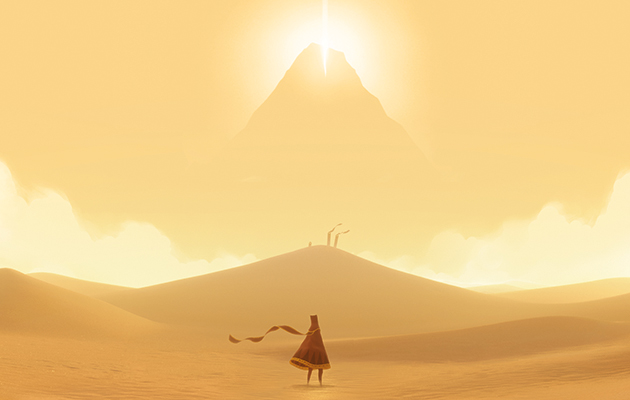![]() Illustration by Tishk Barzanji
Illustration by Tishk Barzanji
Videogames have become an art form for a millennial generation hungry for space and structure. Their responsive architecture and landscapes invite exploration and escapism – even as they fall into apocalyptic ruin, writes Zoyander Street
In 2005, media scholar Henry Jenkins published an essay entitled Videogames as Narrative Architecture – a quasi-manifesto about how the medium uses space to convey meaning, which has become a staple of syllabuses for games studies (now an actual academic discipline). You can apply a narrative architecture reading to almost any game – and this kind of reading of games has in recent years been one of the most fascinating developments in games criticism, and in game design thinking.
 The 2012 Playstation 3 game Journey challenges players to reach the landscape’s limits
The 2012 Playstation 3 game Journey challenges players to reach the landscape’s limits
Featured in the exhibition Videogames: Design/Play/Disrupt at the V&A as a landmark title in artistic indie games, Journey (2012) represents an early materialisation of narrative architecture. As its title subtly implies, it is a game that makes the monomyth spatial:player-characters traverse desert ruins, gradually acquiring physical markers of their progress in the form of a growing scarf that trails in the wind. In the exhibition catalogue, Jordan Erica Webber describes how the game’s spatially distinct ‘levels’ use the qualities of the terrain to express a character’s path through life:
‘The player begins with a period of learning and growth, making their way through the desert … Then they face a period of darkness in an underground lair inhabited by large serpentine creatures that can impede their progress, the mountain goal hidden from view to represent a midlife crisis. Finally, they reach the mountain, and the climbing of this represents death.’
 High-concept meets handmade on the walls of the V&A’s new exhbition Videogames: Design/Play/Disrupt
High-concept meets handmade on the walls of the V&A’s new exhbition Videogames: Design/Play/Disrupt
The use of landscape design as a way of spatially orienting a player is a common architectural motif in videogames. In Journey, the movement from ruined ancient buildings amid sand dunes, through dark caves, to the top of a holy mountain, gives players a sense that they can achieve something epic in scale.
Developers like to brag that vast landscapes are no longer just backdrops painted on to the set but parts of the playable world. When the blockbuster game Skyrim (2011) was first presented at an industry conference broadcast live worldwide, director Todd Howard famously declared, ‘You see that mountain there? You can climb it.’

Back then, the power fantasy of unrestricted movement was a good fit for millennials suffering what were at the time assumed to be temporary setbacks following the credit crunch. It was critiqued in 2013 by queer scholar Samantha Allen, who pointed to games that restrict one’s ability to move through the world physically – whether that be through architecture or landscape – as a meaningful response to the struggles faced in the world by trans people and people of colour. You can read most videogames on this level, by looking at how many possible routes exist through a space, and what objects and systems create friction or barriers to those possible movements. A lot of what people call ‘gameplay’ is the player’s negotiation with a system’s carefully contrived restrictions on their ability to traverse and occupy space.

Games are an art form for a generation hungry for space and for structure – for systems that can be understood, and for places that can be freely explored, occupied and owned. Many of the games included in the V&A exhibition show this need at play, giving players the ability to create their own architectures out of simulated natural environments. For instance, ‘sandbox’ games such as space-exploration simulator No Man’s Sky (2017) make use of a now widely applied design pattern – the environment itself provides materials that can be excavated and stored in an inventory, then used to create new structures and tools. Players can earn their stake in a frontier space, by being the authors of its architecture.
Dwarf Fortress (a work in progress first made public in 2006), one of the first videogames to enter a museum collection when it was acquired by the Museum of Modern Art in 2012, is a key example of this place-making simulation genre, as is the ubiquitous Minecraft (2009). What No Man’s Sky adds to this is an unprecedented scale, with billions of worlds procedurally generated through algorithms that have been finely tuned to maximise players’ visual pleasure and curiosity. It contains an entire universe built to be explored, colonised and shared.

The notion of the contemporary apocalypse offers another, ironically futurist spatial fantasy in videogames. The frontier appears not as manifest on distant worlds, but as right here: a tabula rasa following civilisation’s collapse. The V&A exhibition includes post-apocalyptic game The Last of Us (2013), a title that was the subject of a poignant photo essay by Gareth Damian Martin published in architectural games criticism zine Heterotopias in 2017. Martin argues that The Last of Us portrays a kind of apocalypse that is no longer possible in the anthropocene. In this game’s world, the remains of our contemporary architecture have been overtaken by old nature, as we remember it from before industrialisation. But Martin contends that, looking ahead, mass extinctions of familiar flora and fauna are inevitable. Even the natural disasters and non-human forces that threaten to bring civilisation to its knees will, ironically, be inextricably connected to human activity.
In the exhibition catalogue, Darran Anderson also discusses the idea of the anthropocene in The Last of Us. Martin and Anderson both draw attention to the game’s allusion to images of hugely destructive hurricanes, such as Katrina and Harvey. Anderson sees a possible redemption for humanity in the natural systems taking over the ruined cities in The Last of Us, but Martin cautions that such a return to nature is only a fantasy:
‘Hurricane Harvey has more than likely done massive damage to oyster reefs and seagrass beds on the Texas coast, which will have lasting and significant effects on the region’s ecosystems. There will be no sharks or sea life surging into the environments created by its destructive power, instead they too will have been displaced, and even killed, in their thousands. To recognize the epoch of the Anthropocene is to recognize the complexity of this interrelation.’
 Concept art from The Last of Us, relationships and the environmentalism set in a post-apocalyptic world
Concept art from The Last of Us, relationships and the environmentalism set in a post-apocalyptic world
Games use spatial design to portray a futurity and a dream of growth, even when portraying humanity’s decline. It is hard to imagine a medium such as videogames, with its focus on player agency, portraying a slow loss of power and the entropic decay of life itself. Yet the spaces of magical-realist episodic game Kentucky Route Zero (2013–), also included in the V&A exhibition, achieve just that, through a gradual descent from rural America’s highways to a secret underground river that the protagonists learn about after visiting the fictional Bureau for Reclaimed Spaces. After reaching the river, the game’s spaces become slow as molasses and just as dark.
Failure to fit into the world’s constructed spaces is a theme in many of the characters’ stories, from one’s rejection by the Gaston Trust for Imagined Architecture, to main character Conway’s intensifying state of homelessness and poverty. Kentucky Route Zero’s first episode indicated a road that might lead to a destination where a task could be completed, by simply travelling along the straight lines of a terrain that has already been mapped. But by episode four, the player is slowly drifting in the dark, with a protagonist so deep in debt due to magical-realist healthcare bills that he has given himself into indentured servitude, killing his future – his living death represented by his body’s transformation into an anonymous skeleton.

The second episode of Kentucky Route Zero takes place in institutions dedicated to efforts to preserve or make new use of decaying architecture – the Bureau of Reclaimed Spaces and the Museum of Dwellings. In some sense, the game deliberately undermines its hero’s quest, seemingly denying the player’s ability to become a hero under the weight of a society that is crumbling. But this is still a natural part of the monomyth, in a story that has not yet concluded. After all, the hero cannot grow without losing himself entirely and being ready to die. In the spatial medium of videogames, a form where characters are routinely expected to be reborn after they are slain, it is the death of the world that drives narrative.
The hero’s journey is fundamentally not the growth of the pilgrim from novice to master by climbing the mountain, but the growth of the mountain from foothills populated by the ruined buildings of a world left behind, to an apex seemingly built by forces far larger than humans.

















